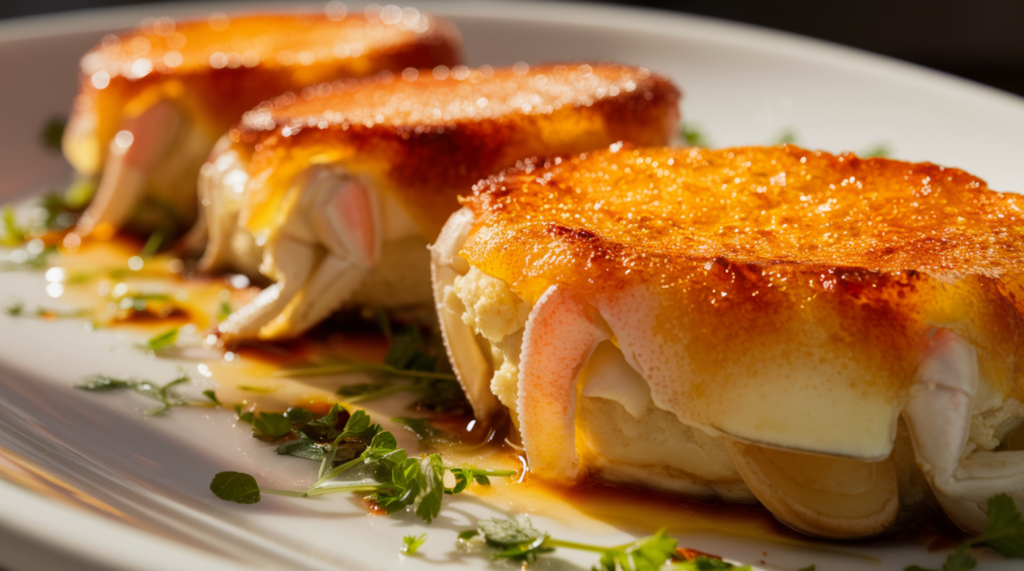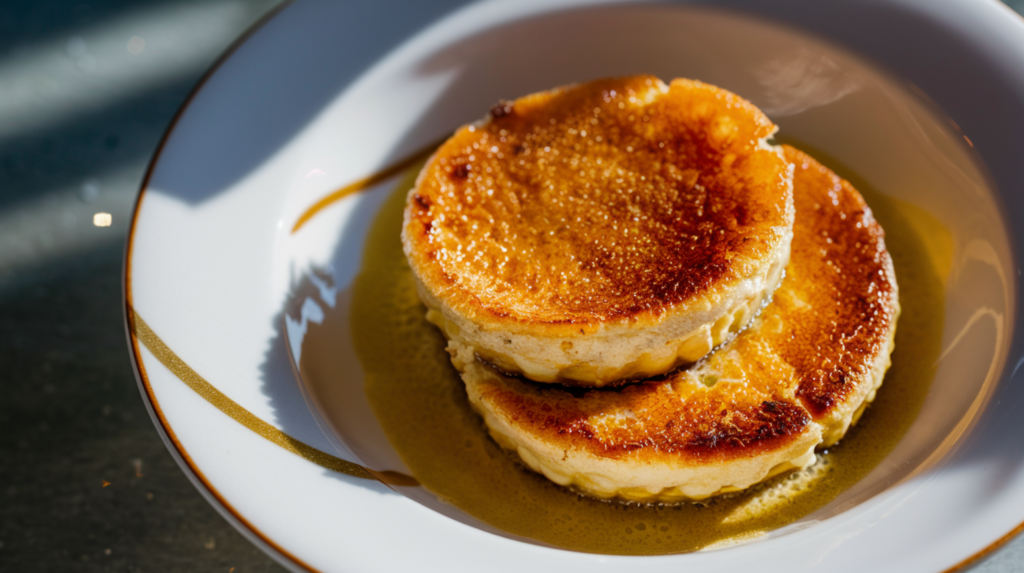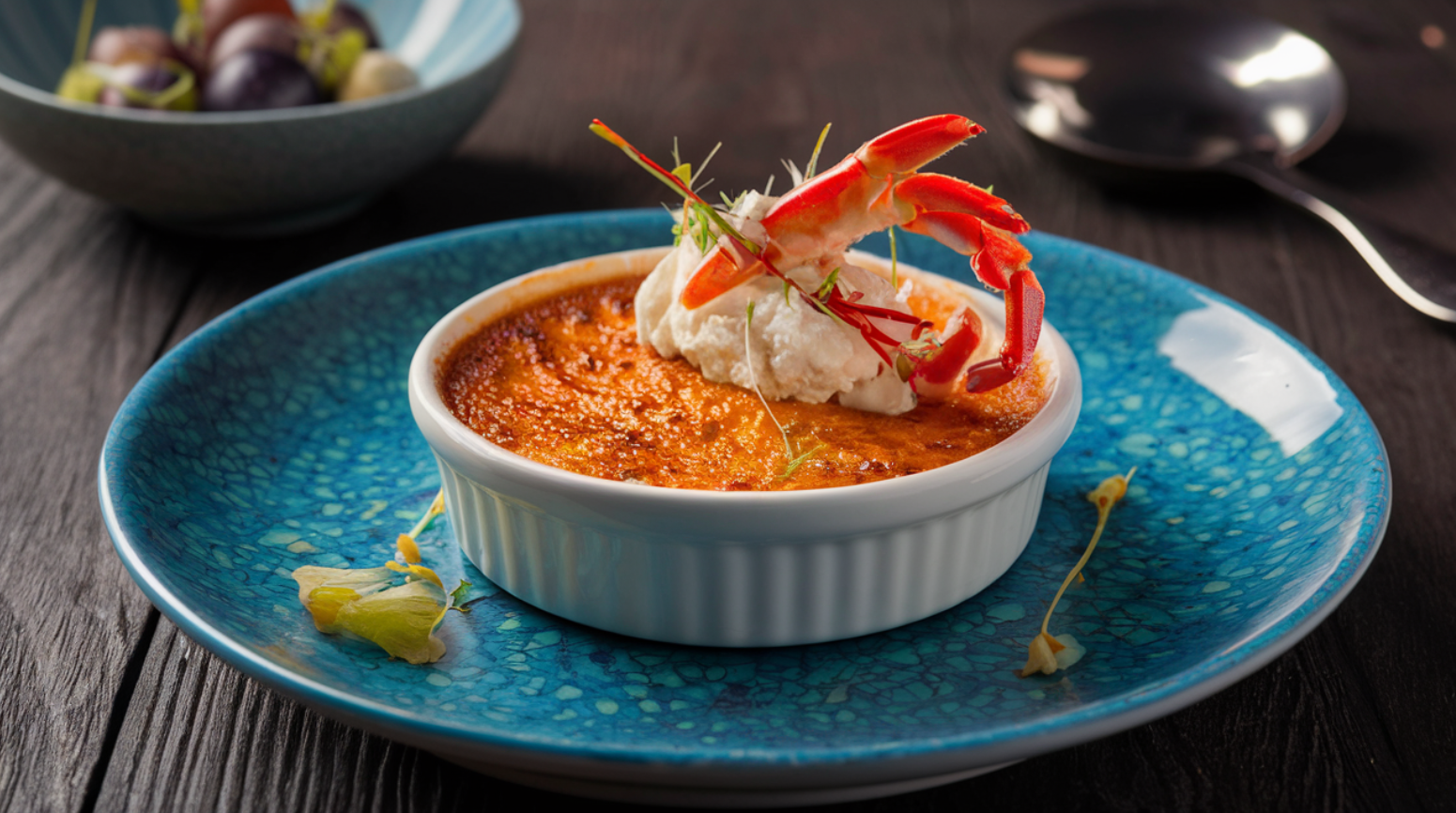Crab Brûlée redefines traditional cuisine by blending the savory richness of crab with the creamy texture of classic crème brûlée. This exquisite recipe merges the best of both worlds, making it an ideal choice for those looking to elevate their dining experience. Whether you’re hosting a special dinner or simply treating yourself, this Crab Brûlée will leave a lasting impression.
Table of Contents:
- Introduction to Crab Brûlée
- The Evolution of Crab Brûlée
- Essential Ingredients for Crab Brûlée
- Detailed Recipe Instructions
- Prepare the Crab Custard Mixture
- Bake the Custards
- Caramelize the Sugar Topping
- Pro Tips for Making the Perfect Crab Brûlée
- Creative Variations to Explore
- Ideal Pairings for Crab Brûlée
- How to Store and Reheat Crab Brûlée
- Frequently Asked Questions (FAQs)
- Final Thoughts on Crab Brûlée
1. Introduction to Crab Brûlée
Crab Brûlée is more than just a dish; it’s a culinary experience that blends the unexpected pairing of savory crab with the creamy, sweet elements of a classic brûlée. As soon as you take your first bite, the harmonious blend of flavors and textures will captivate you. This recipe is ideal for seafood enthusiasts and those who appreciate gourmet cuisine. By mastering Crab Brûlée, you’ll not only impress your guests but also expand your culinary repertoire.
2. The Evolution of Crab Brûlée
Crème brûlée has been a beloved dessert since the 17th century. Traditionally, it’s known for its rich vanilla custard topped with a crisp caramelized sugar crust. However, the savory version, Crab Brûlée, brings a modern twist to this classic dish. Because chefs have started experimenting with traditional desserts by introducing savory elements like crab, the result is an innovative and delicious creation.
Crab Brûlée demonstrates the versatility of crème brûlée by replacing the sweetness of vanilla with the delicate flavor of crab. This dish offers a unique take on a timeless favorite, which is perfect for those interested in exploring modern culinary trends. For even more creative takes on classic recipes, you might also want to check out the recipe of Lobster Bisque or Shrimp Soufflé.
3. Essential Ingredients for Crab Brûlée
Creating the perfect Crab Brûlée begins with understanding the role of each ingredient. Here’s a breakdown of the key components:
Fresh Crab Meat (8 oz)
- Significance: Fresh crab meat is the star of this dish, providing a sweet, slightly briny flavor that pairs beautifully with the custard. For the best taste and texture, fresh crab is recommended.
- Substitutions: If fresh crab isn’t available, high-quality canned crab can be used, though the flavor may be less vibrant. Alternatively, lobster or shrimp can offer a similar luxurious experience.
Heavy Cream (1 cup)
- Significance: Heavy cream gives the custard its rich, velvety texture. The high fat content of the cream is essential for creating a smooth, decadent custard that complements the crab.
- Substitutions: For a lighter version, you can use half-and-half. Although it won’t be as rich, it will still deliver satisfying results. Coconut cream is another option for those seeking a dairy-free alternative.
Egg Yolks (4 large)
- Significance: Egg yolks are the primary thickening agent in the custard, contributing to its silky texture. They also add richness that balances the delicate flavor of the crab.
- Substitutions: There’s no exact substitute for egg yolks, but a combination of whole eggs and egg whites can be used for a lighter custard. Keep in mind that the texture may be slightly different.
Shallots (2 tablespoons, finely chopped)
- Significance: Shallots add a subtle onion flavor that enhances the complexity of the dish without overpowering the crab. They bring a touch of sweetness and depth to the custard.
- Substitutions: If shallots aren’t available, finely chopped sweet onions or scallions can be used as alternatives.
Dijon Mustard (1 teaspoon)
- Significance: Dijon mustard adds a mild tanginess that cuts through the richness of the cream and crab. It also introduces a layer of complexity to the overall flavor profile.
- Substitutions: Whole grain mustard can be used for a heartier texture, or a small amount of mustard powder for a subtler flavor.
Lemon Zest (1 teaspoon)
- Significance: Lemon zest adds a refreshing citrus note that brightens the dish and complements the sweetness of the crab. It’s a simple yet effective way to enhance the overall flavor.
- Substitutions: Lime zest can be used for a different citrus twist, or a tiny splash of white wine vinegar can provide a similar brightening effect.
Fresh Herbs (1 tablespoon, chopped – parsley, chives, or dill)
- Significance: Fresh herbs add both color and flavor, making the dish more vibrant and aromatic. Each herb brings its own unique flavor profile that complements the crab.
- Substitutions: If fresh herbs aren’t available, dried herbs can be used in smaller amounts, though the flavor will be less intense.
Granulated Sugar (2 tablespoons for the brûlée top)
- Significance: The granulated sugar is essential for creating the caramelized crust that defines a brûlée. When torched, it forms a crisp, sweet layer that contrasts beautifully with the savory custard.
- Substitutions: Brown sugar or turbinado sugar can be used for a deeper caramel flavor, but they may not caramelize as evenly.
4. Detailed Recipe Instructions
Making Crab Brûlée might seem complex, but by following these steps, you’ll find it to be both manageable and rewarding. Let’s dive into the process:

Prepare the Crab Custard Mixture
- Sauté the Shallots: Begin by sautéing the finely chopped shallots over medium heat until they become soft and translucent. This should take about 3-4 minutes. Once done, set them aside to cool.
- Mix the Custard: In a medium-sized bowl, whisk together the egg yolks, Dijon mustard, lemon zest, and fresh herbs. Gradually add the heavy cream, whisking until the mixture is smooth and fully combined.
- Incorporate the Crab: Gently fold the crab meat and the cooled shallots into the custard mixture. Be careful to keep the crab lumps intact, as this will provide a delightful texture.
Bake the Custards
- Prepare the Ramekins: Preheat your oven to 300°F (150°C). Divide the crab custard mixture evenly among 4-6 ramekins, depending on their size. Place the ramekins in a large baking dish.
- Create a Water Bath: Carefully pour hot water into the baking dish until it reaches halfway up the sides of the ramekins. This water bath helps to cook the custards gently and evenly.
- Bake to Perfection: Place the baking dish in the oven and bake the custards for 25-30 minutes. The custards should be set around the edges but still have a slight jiggle in the center.
Caramelize the Sugar Topping
- Cool and Chill: After removing the custards from the oven, allow them to cool at room temperature. Once cooled, refrigerate the custards for at least 2 hours until they are fully chilled.
- Torch the Sugar: Right before serving, sprinkle a thin, even layer of granulated sugar on top of each custard. Use a kitchen torch to melt and caramelize the sugar until it forms a crisp, golden crust. If you don’t have a torch, place the ramekins under a broiler, but keep a close watch to prevent burning.
- Serve the Dish: Serve your Crab Brûlée immediately. For an extra touch, garnish with fresh herbs or a lemon wedge.
5. Pro Tips for Making the Perfect Crab Brûlée
For the best results, consider these expert tips when preparing Crab Brûlée:
- Choose Quality Crab Meat: Fresh crab is ideal, but if using canned, make sure it’s well-drained to prevent the custard from becoming watery.
- Avoid Overcooking: Custards can easily overcook, so keep a close eye on them. They should be slightly wobbly in the center when you take them out of the oven.
- Use a Water Bath: The water bath helps the custards cook evenly and prevents them from curdling. Pour the water carefully to avoid splashing it into the ramekins.
- Perfect the Sugar Crust: For an even caramelized layer, hold the torch about 2 inches from the sugar and move it in a circular motion. Avoid focusing on one spot for too long to prevent burning.
6. Creative Variations to Explore
Crab Brûlée is a versatile dish that allows for creative adaptations. Here are some variations to try:
- Crab and Corn Brûlée: Add half a cup of fresh corn kernels to the custard mixture for a sweet, summery twist. The corn adds texture and pairs wonderfully with the crab.
- Spicy Crab Brûlée: Incorporate a pinch of cayenne pepper or a few dashes of hot sauce into the custard base for a spicy kick that complements the creamy custard.
- Lobster Brûlée: Swap the crab for lobster meat to create an equally luxurious dish with a slightly different flavor profile. Lobster’s sweet, delicate flavor pairs beautifully with the custard.
7. Ideal Pairings for Crab Brûlée
To enhance your Crab Brûlée experience, pair it with these complementary dishes and beverages:
- Salad: A simple green salad with citrus vinaigrette or a shaved fennel and arugula salad with lemon dressing provides a refreshing contrast to the rich brûlée.
- Bread: Serve with toasted baguette slices or crostini for a crunchy accompaniment that can help scoop up the custard.
- Wine: A crisp white wine like Sauvignon Blanc or a lightly oaked Chardonnay pairs well with the richness of the custard.
- Champagne: For an extra touch of elegance, serve Crab Brûlée with champagne. The bubbles and acidity balance the creamy custard perfectly.
8. How to Store and Reheat Crab Brûlée
If you have leftovers, here’s how to store and reheat them:
- Storing: Cover the custards with plastic wrap and refrigerate for up to 2 days. Wait to caramelize the sugar until just before serving.
- Reheating: Allow the custards to come to room temperature, then reheat in a 300°F (150°C) oven for 5-10 minutes, just until warmed through. Re-torch the sugar before serving to refresh the crisp top.

9. Frequently Asked Questions (FAQs)
Q: Can I prepare Crab Brûlée in advance?
A: Yes, you can prepare the custard up to 2 days ahead. Bake and chill the custards, but caramelize the sugar just before serving for the best texture.
Q: What should I do if I don’t have a kitchen torch?
A: If you don’t have a kitchen torch, use a broiler to caramelize the sugar. Place the ramekins under the broiler for 1-2 minutes, and keep a close eye on them to prevent burning.
Q: Can I use frozen crab meat?
A: Yes, you can use frozen crab meat, but make sure to fully thaw and drain it to avoid adding excess moisture to the custard.
Q: How can I prevent the custard from curdling?
A: To prevent curdling, bake the custards in a water bath at a low temperature. Remove them from the oven when they are set around the edges but still slightly wobbly in the center.
Q: Can I substitute other seafood for crab?
A: Yes, you can substitute other seafood like lobster or shrimp for crab. This will give the dish a different but equally delicious flavor.
10. Final Thoughts on Crab Brûlée
Crab Brûlée is a dish that stands out for its creativity and sophistication. By combining the delicate flavor of crab with the creamy richness of custard, it offers a unique culinary experience that’s perfect for any special occasion. Whether you’re hosting a dinner party or treating yourself to a gourmet meal, Crab Brûlée is sure to impress.
The harmonious blend of savory and sweet, along with the contrast between the smooth custard and the crisp caramelized top, makes this dish truly unforgettable. So, why not add Crab Brûlée to your next menu and experience the magic for yourself?
For more seafood-inspired recipes, don’t forget to check out our others sections, where you’ll find other delicious ways to incorporate seafood into your cooking.


1 thought on “<strong>Crab Brulee Recipe – The Elegant Dish That’s Easier Than You Think</strong>”